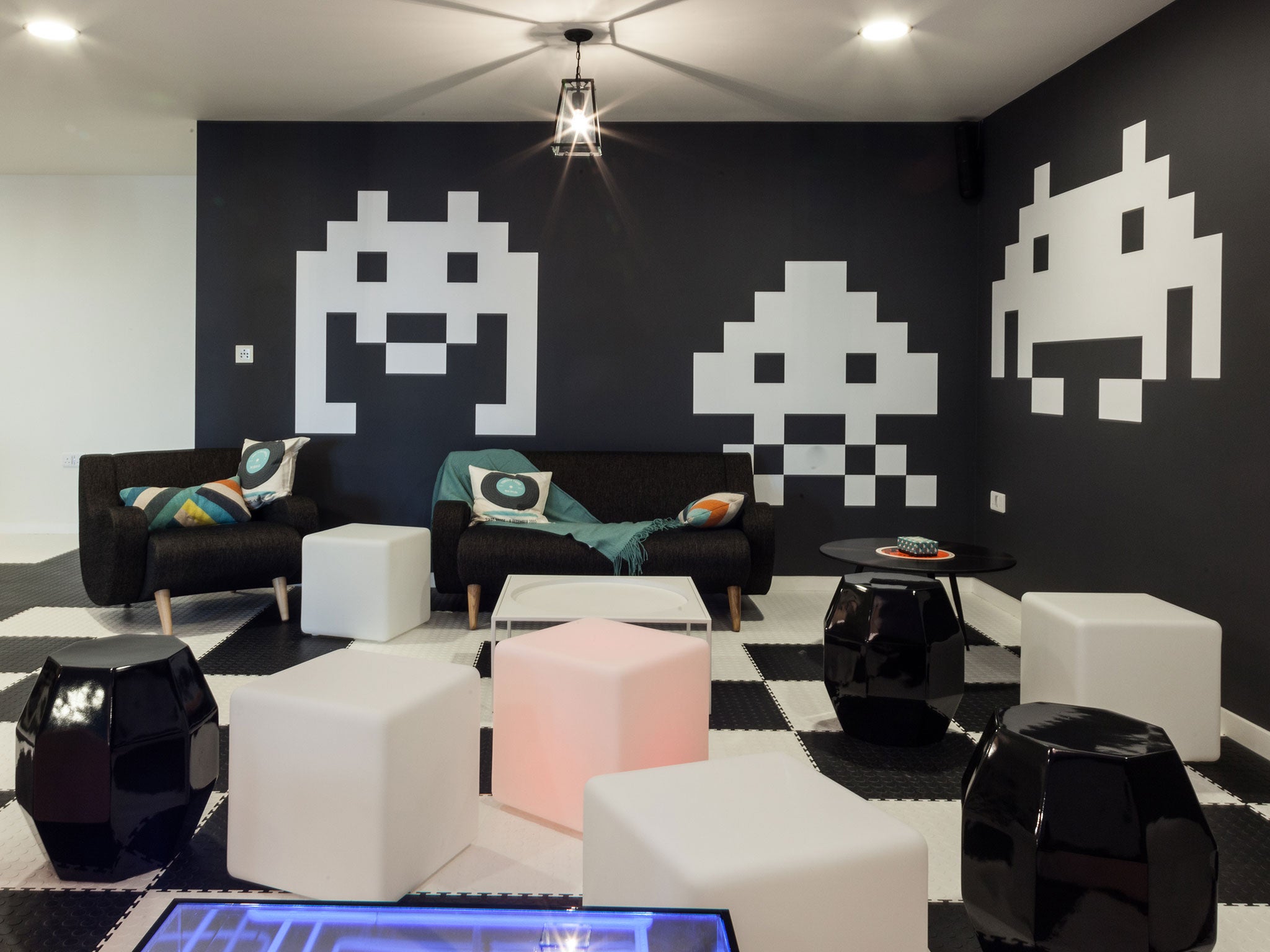Communal living: Meet the millennials living and networking in modern communes
The UK’s first communal living space is fostering unity among tenants, writes Kashmira Gander

When the residents of The Collective communal living space in west London push open their front door they are greeted by a sign emblazoned with the words “Welcome Home!” But don’t be fooled: the notice isn’t hand-carved out of wood by hemp-wearing hippies. It’s a glowing, old-school cinema-style sign, hanging in front of a wall of white neon lights. This is Generation Rent’s slick take on the commune.
The first purpose-built co-living space of its kind in the UK, The Collective Old Oak is at the vanguard of a new housing model also being tested out in New York and other metropolitan US cities. Like similar US set-ups Pure House and WeLive – by the hugely successful WeWork workspace firm – the residents at The Collective stay in student-housing-style rooms with shared communal spaces.
Opened last month, the smell of fresh paint still clings to the walls in the building, which can house up to 546 people. Where a 1960s kibbutz might have had a vegetable patch there is a modern rustic restaurant where diners perch on brown leather seats and drink from the well-stocked bar. Rather than the takeaway menus and adverts for cheap student bars that litter university dorm doorways, the entrance is bright and spacious with a high exposed ceiling. To the right of the reception desk is a seating area furnished with plush velvet Prussian blue poufs and sofas in burnt orange and deep purple, where circular copper light fittings hover like halos. To the left, young professionals flanked by tall potted plants tap away on Macbooks at a large desk.
Nice, yes, but with nine-month contracts starting at £250 a week, the stylish studio flats – 150 sq ft for a single and a 300sq ft for a shared ‘twodio’– are tiny and expensive. And perhaps living in the cultural black hole that is suburban west London isn’t ideal. But the lack of space is made up for by the enviable facilities. Residents are provided with everything from linen to cutlery, and each floor has a stylish kitchen and themed dining rooms.
While the library and spa offers peace and quiet, residents can mingle in the cinema and games rooms or at the laundrette fitted with a disco-ball and a dance floor. The co-working space, currently a bare concrete shell open for public hire in September, will be fitted with a 3D printer and music and photography studios. Of course, signing up is all done online.
Keeping the peace are the community managers who organise and informally interview potential tenants to ensure they share The Collective’s core values: have fun, be kind, be open and think differently. These echo the principles of similar projects including the Common in Brooklyn's Crown Heights, which requires tenants to “lend a hand” and “keep evolving”. Pure House similarly asks residents to “share passions” and “live with integrity”.
It is easy to scoff at communal living as symptomatic of selfish millennials with Peter Pan complexes who blindly throw money into rental money pits to lead aimless nomadic lifestyles they can show off on Instagram. And indeed Melissa Fernandez from the LSE, an expert in alternative housing, argues that such places use the language of companionship to peddle a “temporary capitalist utopia”, with no focus on fostering a long-term settlement that helps the wider community, as in traditional counter-cultural communes.
But in cities where rent is high, housing quality low and buying property nigh impossible, communal living does at least help Generation Rent wrestle back some control from self-interested landlords. And if the hippie ethos only thinly veils the reality that such set-ups are geared for professional networking (as it transpires), isn’t that understandable?
Meanwhile, the varied age of tenants – from 18 to 52 – proves that such projects aren’t youth-obsessed cults, either. “We’ve got all sorts of professions living here, from civil servants to teachers. As long as they have that shared set of values and buy into co-living as a concept they are welcome,” says Stephanie Cornell, The Collective’s head of communications.
“It's a graduate scheme for life. For some, it's a fantastic community of friends; for others it's about finding new business opportunities,” chimes community manager Ed Thomas, who says The Collective is inspired by the free-thinking philosophies behind the Burning Man festival in Nevada and Google.
Chris Bledsoe describes a similar sense of belonging at New York City’s Ollie housing complex, which he founded with his brother.
“It has absolutely validated that, for many New Yorkers, quality of life is not measured in terms of square feet,” he says. “We believe ‘millennial’ is more aptly defined as a mindset rather than an age group, characterised by individuals who are favouring acquisition of experiences over ownership of things.”
So, two months into the project, what is living at The Collective really like? Surely, the glittering exterior is hiding something. Smelly drains? Seething feuds over stolen milk?
Taras Kontek moved into the building after it opened in early May, having previously lived alone in an apartment in Australia. The 31-year-old contract manager admits that the 30-minute train ride to central London can be testing, but says the arrangement is ideal for someone new to a city where it is easy to feel isolated in the throng.
“Having lived on my own for so long, I didn’t really want to go into a shared house and I think that living at The Collective gives me the best of both worlds. I can get as involved in the community activities as I want or if I’m not feeling it at the time I have my own little sanctuary.”
Tracy Eden, the head of a marketing and communications department, joined The Collective to find like-minded individuals who would help her launch her health and fitness business, but has since found a new best friend in her flatmate Rita, and has gladly picked up a few Portuguese phrases, too.

“It’s greatly focused towards social networking and partying hard. Last week we had a giant games night which is big Jenga and Connect Four and that was great fun. It descended into the usual 5am dancing.”
This need to balance privacy and social life is something that Ed Thomas sees in other tenants, too. “I think it [The Collective] is a response to this need to belong. We are always on our phones and we think we are connected to everyone, but the reality it's not as simple as ‘click click click’. Life is actually a bit more complicated than that.”
The social impact of such projects, still in their formative years, and the potential effects on already eye-watering house prices, are yet to be seen. The Collective is open for viewing.
Join our commenting forum
Join thought-provoking conversations, follow other Independent readers and see their replies
Comments